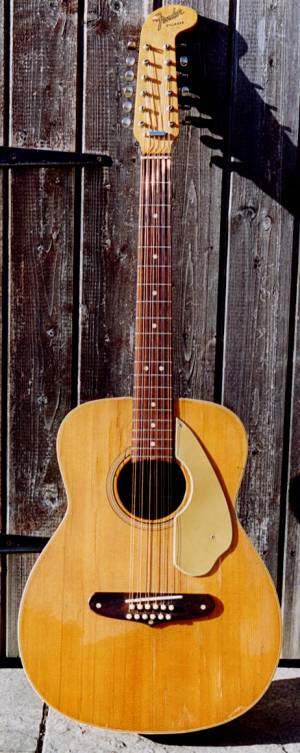
After its acquisition of the Fender company in January 1965, the giant CBS corporation threw its weight behind getting the brand name into as many musical regions as possible. The following Spring saw the genesis of the folk-rock boom, and since Fender was a name very much associated with electric instruments, it was decided to expand the product range into acoustic territory in order to cash in.
Fender had in fact previously produced a small number of acoustic guitars, starting in 1963 with the King and Concert models - Dreadnought sized instruments with electric-styled bolt-on necks - and the short-lived Classic and Folk guitars. They were designed by Roger Rossmeisl, freshly arrived from Rickenbacker who, following some early production set-backs, had hit upon the idea of bracing the acoustic chamber with a central aluminium tube, a device previously utilised by the Larson Brothers of Chicago for their Prairie State models of the 1930's. Rossmeisl was put in charge of designing a complete range of acoustics for CBS, the King being re-named the Kingman, joined by (in descending opulence) the Concert, the Malibu and the Newporter. There were also two 12-strings, the Shenandoah being a 12-string version of the Kingman, and the Villager a 12-string Malibu. All had bolt-on electric necks, and all except the dinky Newporter featured the metal "broomstick" brace.
All of these guitars have since been somewhat ridiculed by serious acoustic players. It's true, they don't sound as good as a Martin or even a low-end Gibson, and those four bolts in the heel are anathema to students of the luthier's craft. However, they have a bright, zingy sound that records very well, lacking the power and boominess of more up-market instruments; that low-fi strumming on the Kinks' "Waterloo Sunset", for example, is Ray Davies' Malibu. The necks are typically extremely comfortable. Rossmeisl was smart enough to fix the laminated plastic pick-guard to the top using two screws, with a series of small felt pads on the under-side, to help vibration transference across the top and reduce the risk of buckling. It's also worth noting that the renowned Taylor guitars, currently enjoying tremendous success, found their niche in the marketplace through the use of a slender electric-style bolt-on neck, albeit stylishly attached to an admittedly superior acoustic body.
This guitar, having spent most of its life in the Nevada desert, has suffered from cracks in the top, which loosened the internal bracing. Kinkade to the rescue! Jonny did a brilliant job of glueing it all back together, making a new nut (the factory job was totally useless) and re-setting the neck. Now it's a player again, and probably performs better than it did when new. Accurate dating of Fender acoustics is impossible - there are no codes anywhere on the guitar - but from the 5-digit serial number, gold headstock decal and Kluson tuners it's probably pre-1967, maybe late 1965. You decide.
Fender never did get a foothold in the acoustic market, and the original American models had disappeared by 1971 despite a few additions and modifications to the range in the late 1960's. I'm very happy with this guitar, particularly as it's a fine example from a quirky period of the company's history that is all but forgotten about today.